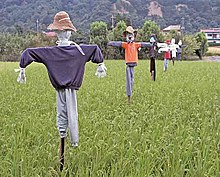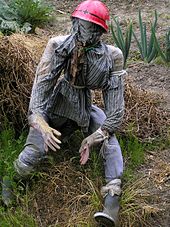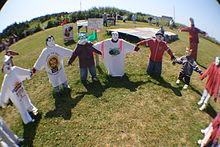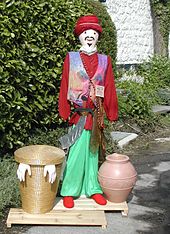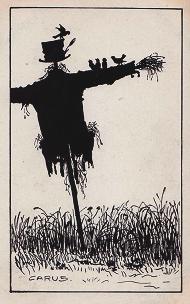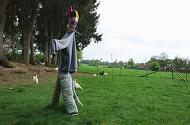 |
Canku Ota
|
 |
|
(Many Paths)
|
||
|
An Online Newsletter
Celebrating Native America
|
||
|
OCTOBER 2020 - Volume
18 Number 10
|
||
|
|
||
|
Scarecrows
|
||
|
by Wikipedia
|
||
A scarecrow is a decoy or mannequin, often in the shape of a human. Humanoid scarecrows are usually dressed in old clothes and placed in open fields to discourage birds from disturbing and feeding on recently cast seed and growing crops. Scarecrows are used across the world by farmers, and are a notable symbol of farms and the countryside in popular culture. Design
The common form of a scarecrow is a humanoid figure dressed in old clothes and placed in open fields to discourage birds such as crows or sparrows from disturbing and feeding on recently cast seed and growing crops. Machinery such as windmills have been employed as scarecrows, but the effectiveness lessens as animals become familiar with the structures. Since the creation of the humanoid scarecrow, more effective methods have been developed. On California farmland, highly reflective aluminized PET film ribbons are tied to the plants to create shimmers from the sun. Another approach is using automatic noise guns powered by propane gas. One winery in New York has even used inflatable tube men or airdancers to scare away birds. Cultural impact In Kojiki, the oldest surviving book in Japan (compiled in the year 712), a scarecrow known as Kuebiko appears as a deity who cannot walk, yet knows everything about the world. Nathaniel Hawthorne's short story "Feathertop" is about a scarecrow created and brought to life in 17th century Salem, Massachusetts, by a witch in league with the devil. The basic framework of the story was used by American dramatist Percy MacKaye in his 1908 play The Scarecrow. L. Frank Baum's tale The Wonderful Wizard of Oz has a scarecrow as one of the main protagonists. The Scarecrow of Oz was searching for brains from the Great Wizard. The scarecrow was portrayed by Frank Moore in the 1914 film His Majesty, the Scarecrow of Oz, by Ray Bolger in the 1939 film The Wizard of Oz, and by Michael Jackson in the 1978 musical film adaptation The Wiz. Worzel Gummidge, a scarecrow who came to life in a friendly form, first appeared in series of novels by Barbara Euphan Todd in the 1930s and later in a popular television adaptation. The Scarecrow is the alter ego of the Reverend Doctor Christopher Syn, the smuggler hero in a series of novels written by Russell Thorndike. The story was made into the movie Doctor Syn in 1937, and again in 1962 as Captain Clegg. It was taken up by Disney in 1963 and dramatized in the three-part TV miniseries The Scarecrow of Romney Marsh starring Patrick McGoohan; this was later re-edited and released theatrically as Dr. Syn, Alias the Scarecrow. A film directed by Jerry Schatzberg in 1973 starring Al Pacino and Gene Hackman is titled Scarecrow and deals with two characters on a journey reminiscent of the one in L. Frank Baum's book. The Scarecrow is a character in the DC Comics universe, a supervillain and antagonist of Batman; Cillian Murphy portrays the character in Christopher Nolan's Batman trilogy. Similar characters, known as Scarecrow and Straw Man, have appeared in Marvel Comics. British band Pink Floyd recorded a song called "The Scarecrow" for their debut album, The Piper at the Gates of Dawn. John Cougar Mellencamp's album Scarecrow, which peaked at No. 2 in 1985, spawned five Top 40 singles including "Rain on the Scarecrow" (#21). The song "Scarecrow People" on the XTC album Oranges & Lemons is a cautionary tale about the evolution of mankind to 'scarecrow people' who 'ain't got no brains' and 'ain't got no hearts' and are the result of humans destroying their world with wars and pollution. Melissa Etheridge recorded the song "Scarecrow" for her 1999 album Breakdown. The song is actually about Matthew Shepard. The title makes reference to the bicyclist who found Shepard murdered and tied to a fence, and mistook him as a scarecrow upon first glance. Tobias Sammet recorded his third Avantasia album with a title The Scarecrow, as a first part of Wicked Trilogy.
A scarecrow named Scarecrow is one of the protagonists in Magic Adventures of Mumfie. Joe's Scarecrow Village in Cape Breton, Canada, is a roadside attraction displaying dozens of scarecrows. The Japanese village of Nagoro, on the island of Shikoku in the Tokushima Prefecture, has 35 inhabitants but more than 350 scarecrows. In the United Kingdom, where the use of scarecrows as a protector of crops dates from time immemorial and where there are a few different languages and several different dialects, there are a wide range of alternative names such as:
Scarecrow festivals
In England, the Urchfont Scarecrow Festival was established in the 1990s and has grown into a major local event, attracting up to 10,000 people annually for the May Day Bank Holiday. Originally based on an idea imported from Derbyshire, it was the first Scarecrow Festival to be established in the whole of southern England. Belbroughton, north Worcestershire, holds an annual Scarecrow Weekend on the last weekend of each September since 1996, which raises money for local charities. The village of Meerbrook in Staffordshire holds an annual Scarecrow Festival during the month of May. Tetford and Salmonby, Lincolnshire, jointly host one. The festival at Wray, Lancashire, was established in the early 1990s and continues to the present day. In the village of Orton, Eden, Cumbria scarecrows are displayed each year, often using topical themes such as a Dalek exterminating a Wind turbine to represent local opposition to a wind farm. The village of Blackrod, near Bolton in Greater Manchester, holds a popular annual Scarecrow Festival over a weekend usually in early July. Norland, West Yorkshire, has a Scarecrow festival. Kettlewell in North Yorkshire has held an annual festival since 1994. In Teesdale, County Durham, the villages of Cotherstone, Staindrop and Middleton-in-Teesdale have annual scarecrow festivals. Scotland's first scarecrow festival was held in West Kilbride, North Ayrshire, in 2004, and there is also one held in Montrose. On the Isle of Skye, the Tattie bogal event is held each year, featuring a scarecrow trail and other events. Tonbridge in Kent also host an annual Scarecrow Trail, organised by the local Rotary Club to raise money for local charities. Gisburn, Lancashire, held its first Scarecrow Festival in June 2014. Mullion, in Cornwall, has an annual scarecrow festival since 2007. In the US, St. Charles, Illinois, hosts an annual Scarecrow Festival. Peddler's Village in Bucks County, Pennsylvania, hosts an annual scarecrow festival and presents a scarecrow display in September–October that draws tens of thousands of visitors. The 'pumpkin people' come in the fall months in the valley region of Nova Scotia, Canada. They are scarecrows with pumpkin heads doing various things such as playing the fiddle or riding a wooden horse. Hickling, in the south of Nottinghamshire, is another village that celebrates an annual scarecrow event. It is very popular and has successfully raised a great deal of money for charity. Meaford, Ontario, has celebrated the Scarecrow Invasion since 1996. In the Philippines, the Province of Isabela has recently started a scarecrow festival named after the local language: the Bambanti Festival. The Province invites all its Cities and Towns to participate for the festivities, that lasts a week, and has drawn tourists from around the island of Luzon. The largest gathering of scarecrows in one location is 3,812 and was achieved by National Forest Adventure Farm (UK) in Burton-upon-Trent, Staffordshire, UK, on 7 August 2014. Gallery
|
||||||||||||||||||||||||||||||||||||
|
|
||
|
|
||
| Canku Ota is a free Newsletter celebrating Native America, its traditions and accomplishments . We do not provide subscriber or visitor names to anyone. Some articles presented in Canku Ota may contain copyright material. We have received appropriate permissions for republishing any articles. Material appearing here is distributed without profit or monetary gain to those who have expressed an interest. This is in accordance with Title 17 U.S.C. Section 107. | ||
|
Canku Ota is a copyright ©
2000 - 2020 of Vicki Williams Barry and Paul Barry.
|
||
 |
 |
|
|
The "Canku
Ota - A Newsletter Celebrating Native America" web site and
its design is the
|
||
|
Copyright ©
1999 - 2020 of Paul C. Barry.
|
||
|
All Rights Reserved.
|
||
